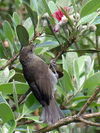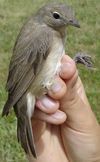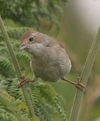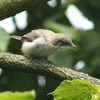Genus Sylvia

Hume's Whitethroat - Unlike many typical warblers, the sexes are almost identical. This is a small species with a grey back, whitish underparts, a grey head with a darker "bandit mask" through the eyes and a white throat. It is slightly smaller than the Whitethroat, and lacks the chestnut wings and uniform head-face color of that species. The Lesser Whitethroat's song is a fast and rattling sequence of tet or che calls, quite different from the Whitethroat's scolding song.
Blackcap - It is a robust typical warbler, mainly grey in plumage. Like most Sylvia species, it has distinct male and female plumages: The male has the small black cap from which the species gets its name, whereas in the female the cap is light brown. This is a bird of shady woodlands with ground cover for nesting. The nest is built in a low shrub, and 3–6 eggs are laid. The song is a pleasant chattering with some clearer notes like a Blackbird. This full song can be confused with that of the Garden Warbler, but in the Blackcap, it characteristically ends with an emphatic fluting warble. Especially in isolated Blackcap populations , a simplified song can occur. This song is said to have a Leiern-type ending after the term used by German ornithologists who first described it. The introduction is like that in other Blackcaps, but the final warbling part is a simple alteration between two notes, as in a Great Tit's call but more fluting .
Banded Warbler - The Banded Warbler is a species of Old World warbler in the Sylviidae family. It is found in Ethiopia, Kenya, Somalia, and Tanzania. Its natural habitat is dry savanna.
Garden Warbler - This is a nondescript bird, 13-14.5 cm long, mainly brown-grey above and whitish below. It has no obvious distinctive features. Like most "warblers", it is insectivorous. It is a species of shady woodlands with ground cover for nesting. The nest is built in low shrub or brambles, and 3-7 eggs are laid.
Yemen Warbler - The Yemen Parisoma is a species of Old World warbler in the Sylviidae family. It is found in Saudi Arabia and Yemen. Its natural habitat is subtropical or tropical dry forests. It is threatened by habitat loss.
Subalpine Warbler - Like most Sylvia species, it has distinct male and female plumages. The adult male has a grey back and head, brick-red underparts, and white malar streaks . The female is mainly brown above, with a greyer head, and whitish below with a pink flush. The Subalpine Warbler's song is fast and rattling, and is similar to the Lesser Whitethroat.
Common Whitethroated - This is one of several Sylvia species that has distinct male and female plumages. Both sexes are mainly brown above and buff below, with chestnut fringes to the secondary remiges. The adult male has a grey head and a white throat. The female lacks the grey head, and the throat is duller. The Whitethroat's song is fast and scratchy, with a scolding tone.
Spectacled Warbler - It also occurs in tome Atlantic islands. The subspecies orbitalis has been proposed for those of the Cape Verde Islands. The presumed subspecies for the Madeira birds, bella is today usually included in this taxon, as are the nirds of the Canary Islands, where the species is quite common except on El Hierro and known as zarzalero y ratonero .
Lesser Whitethroat - Unlike many typical warblers, the sexes are almost identical. This is a small species with a grey back, whitish underparts, a grey head with a darker "bandit mask" through the eyes and a white throat. It is slightly smaller than the Whitethroat, and lacks the chestnut wings and uniform head-face color of that species. The Lesser Whitethroat's song is a fast and rattling sequence of tet or che calls, quite different from the Whitethroat's scolding song.
Tristram's Warbler - The Tristram's Warbler is a species of Old World warbler in the Sylviidae family. It is found in Algeria, Libya, Mauritania, Morocco, Tunisia, and Western Sahara. Its natural habitat is subtropical or tropical dry shrubland.
Orphean Warbler - At 15–16 cm length - somewhat larger than a Blackcap - this is one of the largest species of typical warblers. The adult males have a plain grey back and whitish underparts. The bill is long and pointed and the legs black. The male has a dark grey head, black eye mask and white throat. The iris is white. Females and immatures have a paler head and buff underparts; their grey back has a brownish tinge. The iris is dark in young birds. The song is a series of warbling liroo-liroo and scolding notes.
Layard's Warbler - The Layard's Warbler is a species of Old World warbler in the Sylviidae family. It is found in Lesotho, Namibia, and South Africa. Its natural habitat is subtropical or tropical dry shrubland.
Brown Warbler - The Brown Warbler Sylvia lugens is a typical warbler found in Africa.
Sardinian Warbler - The Sardinian Warbler, Sylvia melanocephala, is a common and widespread typical warbler from the Mediterranean region.
Cyprus Warbler - Like most Sylvia species, it has distinct male and female plumages. The adult male is a small typical warbler with a grey back, black head, white malar streaks , and, uniquely among typical warblers, underparts heavily streaked with black. The female is mainly grey above, with a greyer head, and whitish with only light spotting. The Cyprus Warbler's song is fast and rattling, and is similar to that of the Sardinian Warbler.
Small Whitethroat - Unlike many typical warblers, the sexes are almost identical. This is a small species with a grey back, whitish underparts, a grey head with a darker "bandit mask" through the eyes and a white throat. It is slightly smaller than the Whitethroat, and lacks the chestnut wings and uniform head-face color of that species. The Lesser Whitethroat's song is a fast and rattling sequence of tet or che calls, quite different from the Whitethroat's scolding song.
M - The Menetries's Warbler is 12 to 14 cm long with a wingspan of 15 to 19 cm and weighs about 9-11 grams. Its fairly long tail is blackish with white on the outer-feathers and is often held cocked. It is frequently wagged up and down or from side to side. The bill is fairly heavy and is dark with a pinkish patch at the base. There is a pale bare ring around the eye.
Desert Warbler - Sexes are almost identical in both. This is a small "warbler" with a sand-coloured back and head, whitish underparts, and a yellow eye. Like its relatives, it is insectivorous, but will also take berries. The song is a distinctive jingle often given in an advertisement flight.
Barred Warbler - This is a large and robust species of typical warbler, 15.5-17cm in length, mainly grey above and whitish below. The adult male is darker grey above, and heavily barred below. The female has only light barring. Young birds lack any barring, and have no obvious distinctive features other than the size. The Barred Warbler is a bird of open country with bushes for nesting. The nest is built in low shrub or brambles, and 3-7 eggs are laid. Like most warblers, it is insectivorous, but will also take berries and other soft fruit. The Barred Warbler's song is a pleasant chattering with many clearer notes like a Blackbird. The song can be confused with that of Garden Warbler, but is less melodious.
R - It is a typical "sylvia" warbler, similar in size but slimmer than Sardinian Warbler. The adults have a plain grey back and paler grey underparts. The bill is fine and pointed, with brown legs and red eyes. The striking male has a black head and, usually, a black throat, separated by a white malar streak . Females have a pale throat, and the head is grey rather than black. Their grey back has a brownish tinge. The song is a slower, deeper rattle than that of Sardinian Warbler.
Marmora's Warbler - These are small, long tailed, large-headed birds, overall very similar to their close relatives in thr Dartford Warbler group. Marmora's Warblers are grey above and below, lacking the brick-red underparts of the Dartford Warbler. Adult males have darker patches on the forehead and between the eye and the pointed bill. The legs and iris are red. The song is a fast rattle. Immature birds can be confused with young Dartford Warblers, which are also grey below, but Marmora's have a paler throat. Their iris is dark.
Sylvia subcaerulea - The Rufous-vented Warbler breeds in southern Africa in Angola, Botswana, Zimbabwe, Zambia, Namibia, South Africa, Lesotho, Mozambique and Swaziland. This is a common species found in a range of habitats fynbos, scrub, thickets and dry riverbeds.
Dartford Warbler - Like many typical warblers, this small passerine bird has distinct male and female plumages. The male of this small Sylvia has a grey back and head, reddish underparts, and a red eye . The reddish throat is spotted with white. The female is paler below, especially on the throat, and a browner grey below. The song is a distinctive rattling warble.







